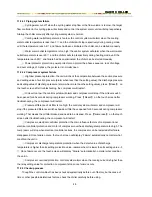
HAIER CHILLER
9. Control device
The core component adopts touching type screen; the surface is dialog type, easy to operate.
The whole control device is highly automatic and highly reliable.
9.1 System diagram
1. air-liquid segregator 2. 4-way valve 3. safety valve 4. high pressure sensor 5. high temperature
expansion valve 6. compressor 7. expansion valve 8. liquid supply solenoid valve 9. evaporator
10. thermostatic expansion valve for cooling 11. one-way valve 12. filter drier 13. ball valve 14. corner
valve 15. thermostatic expansion valve for heating 16. one-way valve 17. condenser 18. ball valve
19. one-way valve 20. one-way valve 21. thermostatic expansion valve for heating 22. liquid spray solenoid
valve 23. low pressure sensor
The compressor takes in low-pressure superheat refrigerating gas from the dry-type evaporator and
compresses it into high-pressure, high-temperature steam-gas. The steam-gas discharges heat to the ambient
environment when going through the condenser and is condensed into saturated or super-cool refrigerating
liquid, which flow is regulated and pressure reduced through expansion valve. Then, the liquid flows into the
dry-type evaporator, where it absorbs heat from cold water, gasifies and is again taken in by the compressor to
start a new cycle. Thus, the cold water passing the dry-type evaporator is cooled down and flows into the
air-conditioning area.
In heat pump cycle, the direction of refrigerant flow is switched over by means of four-way valve. After being
compressed by the compressor, the high-pressure, high-temperature refrigerating gas is directly discharged into
the shell and tube heat exchanger (dry-type evaporator) and heat is released to cold water in this process to
realize heating. The condensed refrigerant flows through expansion valve, where its flow is regulated and
pressure reduced and then evaporates in the air-cool condenser by absorbing ambient heat. The gas is then
34
















































